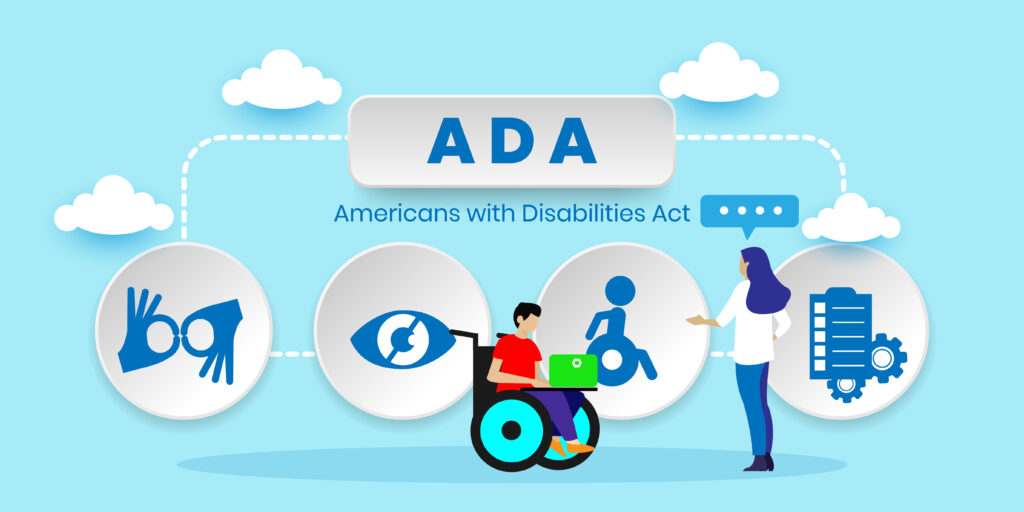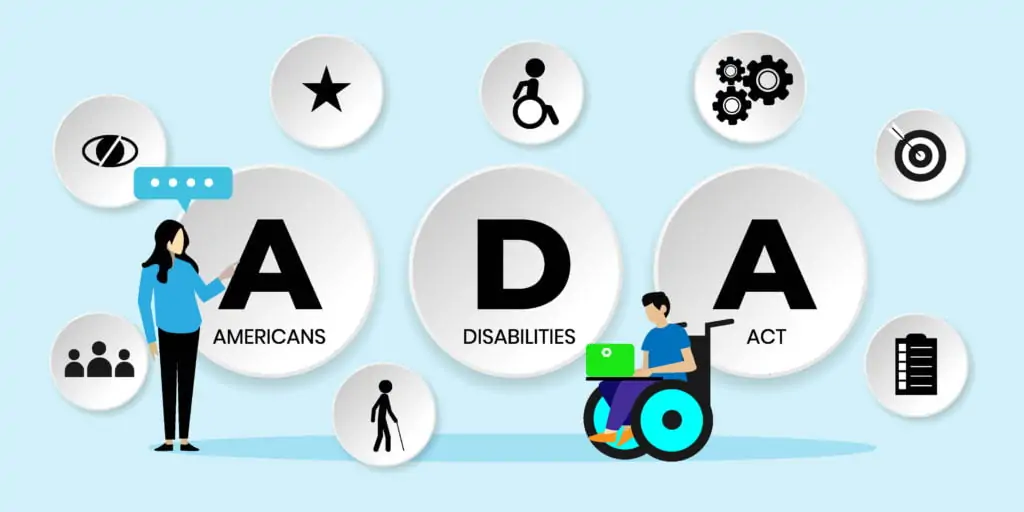ADA Compliance in the digital landscape has become an undeniable cornerstone of modern life. Information and services are increasingly delivered online, from education and employment to shopping and entertainment. This creates a vital need for ensuring equal access for everyone, including those with disabilities. This is where ADA compliance comes in.
Why ADA Compliance Matters?
The Americans with Disabilities Act (ADA) is a landmark civil rights law enacted in 1990. It prohibits discrimination against individuals with disabilities in all areas of public life, including employment, transportation, public spaces, and telecommunications. With the rise of the internet, the ADA’s reach has extended to the digital sphere, ensuring websites and digital content are accessible to people with disabilities.

Here’s why ADA compliance matters:
- Equal Access: It ensures everyone, regardless of ability, can access the information and services offered through websites and digital platforms. This fosters inclusion and empowers individuals with disabilities to participate fully in society.
- Legal Obligation: The Department of Justice (DOJ) considers websites public accommodations under Title III of the ADA. Non-compliance can lead to lawsuits, hefty fines, and reputational damage.
- Expanding Market: Over 61 million adults in the United States live with a disability, representing a significant market segment. ADA compliance opens doors to this vast potential customer base.
- Improved User Experience: Many accessibility features benefit everyone, not just users with disabilities. Clear visuals, keyboard navigation, and descriptive text enhance the overall user experience for all visitors.
- Search Engine Optimization (SEO): Accessible websites tend to be more SEO-friendly. Features like clear navigation and proper coding structure make websites easier for search engines to crawl and index, potentially boosting search ranking.
Benefits of ADA Compliance
Beyond legal compliance, ADA compliance offers a multitude of benefits for businesses and organizations:
- Brand Reputation: Demonstrates commitment to inclusivity and social responsibility, fostering positive brand perception and customer loyalty.
- Increased Innovation: Focus on accessibility can lead to innovative solutions that benefit everyone, driving creativity and pushing digital boundaries.
- Employee Satisfaction: Creating an inclusive workplace through accessible technology empowers employees with disabilities and fosters a positive work environment.
- Reduced Development Costs: Implementing accessibility features from the outset is more cost-effective than retrofitting websites later.
Ready to unlock the full potential of your website?
Contact Kavcom Expert today for a free consultation and learn how we can help you achieve ADA compliance.
Do I Need ADA Compliance?
While the specific legal landscape surrounding ADA compliance and websites is still evolving, there are strong indications that most websites need to be compliant. Here’s what you need to consider:
- Public Accommodation: If your website offers goods or services to the public, it’s likely considered a public accommodation under the ADA. This includes businesses, educational institutions, government agencies, and non-profit organizations.
- State and Local Laws: Some states and localities have enacted their own accessibility laws that may apply to websites. It’s crucial to research any specific regulations in your jurisdiction.
Getting Started with ADA Compliance
While the path to ADA compliance may seem daunting, it can be achieved in a step-by-step approach:

- Evaluate Your Website: Conduct a thorough accessibility audit to identify areas where your website falls short. Several online tools and accessibility testing services are available.
- Prioritize Accessibility Features: Focus on implementing core accessibility features that address the needs of the most common disabilities, including visual, auditory, motor, and cognitive impairments.
- Remediate Issues: Address the identified accessibility issues by modifying website code, design elements, and content presentation.
- Maintain Accessibility: Integrate accessibility best practices into your website development and management processes to ensure ongoing compliance.
Key Considerations for ADA Compliance
Here are some key aspects to address when working towards an ADA-compliant website:
- WCAG Guidelines: The Web Content Accessibility Guidelines (WCAG) published by the World Wide Web Consortium (W3C) provide a comprehensive framework for website accessibility. WCAG 2.1 is the current recommended standard, outlining four core principles: Perceivable, Operable, Understandable, and Robust (POUR).
- Alternative Text Descriptions: Provide clear and concise alternative text descriptions for all images and non-text content, allowing users who rely on screen readers to understand the information presented.
- Keyboard Navigation: Ensure all website elements can be accessed and interacted with using a keyboard alone, catering to users with mobility limitations or who use screen readers.
- Color Contrast: Maintain sufficient color contrast between text and background elements to ensure readability for users with visual impairments.
- Closed Captions and Transcripts: Provide closed captions for video content and transcripts for audio content to benefit users who are deaf or hard of hearing.
Common ADA Compliance Myths (Continued)
- Myth: Accessibility makes websites ugly. Accessibility features often involve clear design principles and improved usability, potentially enhancing the overall user experience for everyone.
- Myth: Websites don’t need to be accessible if they already have a mobile version. Mobile accessibility is crucial, but it’s not a substitute for broader ADA compliance across all platforms.
- Myth: Accessibility is only for people with visual impairments. Accessibility addresses a wide range of disabilities, including visual, auditory, motor, and cognitive impairments.
- Myth: Fixing accessibility issues is expensive. Implementing accessibility features during website development is cost-effective. Retrofitting existing websites can be more expensive, highlighting the importance of proactive planning.
- Myth: Automated tools guarantee ADA compliance. While automated tools can help identify potential accessibility issues, human expertise is necessary for thorough evaluation and remediation.
Frequently Asked Questions (FAQs) on ADA Compliance
Q: What are the penalties for non-compliance with ADA website accessibility? A: The specific penalties for non-compliance can vary depending on the nature of the complaint and the website owner’s efforts to achieve accessibility.
However, potential consequences include:
- Lawsuits: Individuals with disabilities can file lawsuits against non-compliant entities.
- Financial settlements: Settlements can reach significant sums, depending on the severity of the non-compliance.
- Negative publicity: Lawsuits and non-compliance can damage an organization’s reputation.
Q: Is there a specific deadline for achieving ADA compliance for websites? A: There’s no single, federally mandated deadline for website accessibility under the ADA. However, the Department of Justice (DOJ) has taken enforcement actions against non-compliant websites, highlighting the growing importance of accessibility.
Q: Where can I find resources to learn more about ADA compliance? A: Several resources are available to help you understand and implement ADA compliance for your website. Here are a few key ones:
- The Department of Justice (DOJ) website provides information on the ADA and website accessibility: https://www.justice.gov/crt/disability-rights-section
- The World Wide Web Consortium (W3C) publishes the Web Content Accessibility Guidelines (WCAG): https://www.w3.org/WAI/
- The National Center for Disability and Journalism (NCDJ) offers resources and training on accessible web design: https://ncdj.org/
Conclusion
ADA compliance is not just a legal requirement but an ethical imperative ensuring everyone has equal access to the digital world. By prioritizing accessibility, you’re not only fulfilling your legal obligations but also creating a more inclusive and user-friendly online experience for everyone.
- Provide more in-depth explanations of the WCAG guidelines and how to implement them on your website.
- Include specific case studies of organizations that have successfully achieved ADA compliance and the benefits they’ve experienced.
- Offer practical tips and best practices for website development teams to integrate accessibility into their workflow.
- Discuss emerging technologies like Artificial Intelligence (AI) and their potential role in enhancing website accessibility.
- Create a glossary of key terms related to ADA compliance and website accessibility.
- Offer additional resources, such as accessibility testing tools and compliance checklists.
By providing a comprehensive and informative resource, you can empower businesses and organizations to navigate the path toward ADA compliance and create a more inclusive digital landscape for everyone.
Ready to unlock the full potential of your website?
Contact Kavcom Expert today for a free consultation and learn how we can help you achieve ADA compliance.






